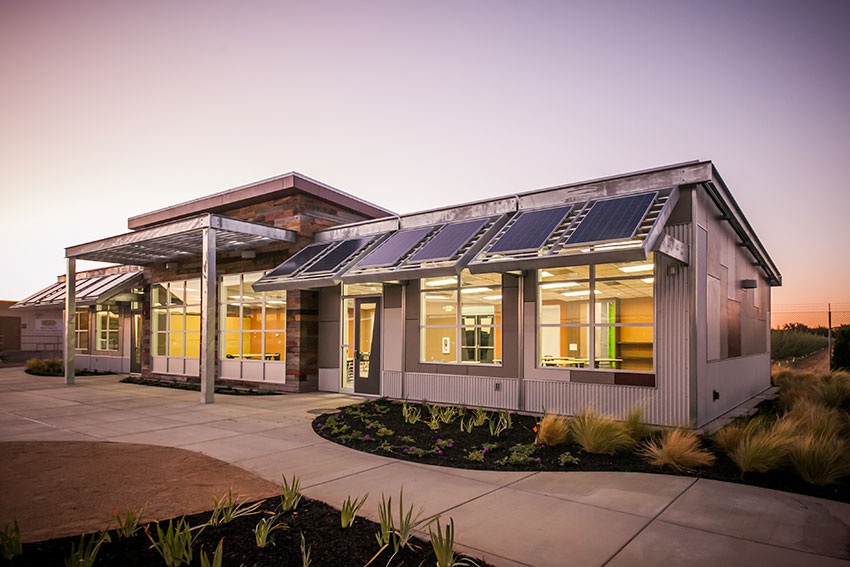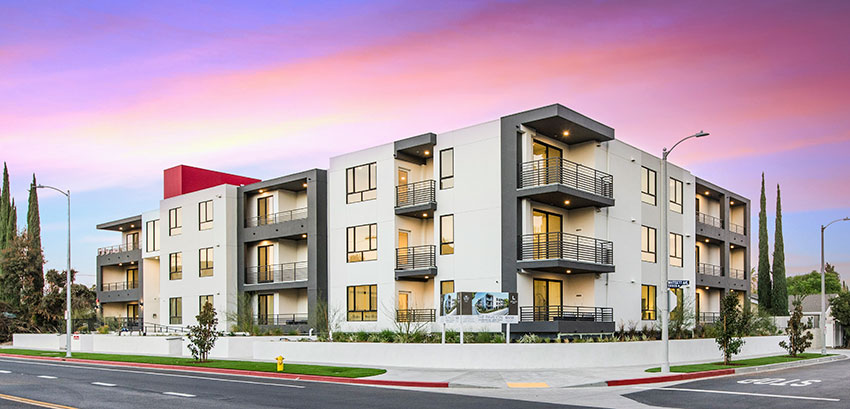Specifying Aluminum High-Performance Windows and Doors
Aluminum maintains its original structural integrity over a long service life and even becomes stronger in extremely cold temperatures. Extruded aluminum building components also resist deformation caused by climate changes and building movement and retain their basic structure, strength, stability, durability, and resistance to water and air infiltration.
NFRC labels help compare energy-efficient products by breaking down a product’s energy performance into multiple categories such as those illustrated on the label. NAFS (North American Fenestration Standard) is a fenestration standard based on the design pressure (DP) concept. It defines basic performance requirements for a wide variety of styles of window, door, and skylight products, including those with aluminum or vinyl cladding. It relies on performance class and performance grade designations to guide this evaluation and selection process. Its four performance classes are R (residential), LC (light commercial), CW (commercial), and AW (architectural).
Wildfire Zones
The prime factor related to fire is the glazing, but noncombustible aluminum frames hold the glazing longer than many other framing materials. Double glazing provides better protection over single glazing. Tempered glass, which is four times stronger (more resistant) than single-pane annealed and twice the strength of a dual pane, increases the fire resistance further.
The California Building Code requires multipane glazing with at least one pane tempered and the window to be rated for 20 minutes. Rated systems must have rated glazing and frames and survive the hose stream test, NFPA 257. They must also meet the State Fire Marshal standard 12-7A-2, which requires exterior windows to meet a fire resistance test standard consisting of a 150 kW intensity direct flame exposure for an eight-minute duration.
Fire-protective glass prevents the spread of fire and smoke, but not heat transfer. When the glass heats up on one side, objects on the other side of the glass will feel the heat. vFire-resistive glass prevents the spread of fire and smoke and also stops radiant and conductive heat transfer. Objects on the protected side do not get hot enough to spontaneously combust. This is usually accomplished with a laminated assembly composed of multiple glass layers separated by heat-resistant interlayers.
Thermally Improved Extrusions
Roughly half of the current improvement to U-factors comes from recent improvements to thermal barriers. There are two principal types of thermal barriers: polyurethane poured and debridged and polyamide insulating strut.
The pour-and-debridge method involves pouring a polyurethane-based mixture into the thermal break channel of an aluminum extrusion. Once it cures, the barrier channel is debridged, which means the metal bridge from the bottom of the channel is removed to produce a structural thermal barrier between the metal surfaces. These systems are available in either single- or double-poured and debridged thermal barriers in the same aluminum extrusion. They provide a range of products to complement the glass selected and to meet specific project performance and budget needs.
While this is the older method, it is still in widespread use. Its disadvantage is that the thermal barrier width is typically limited to about 0.25 inch (6.35 mm) by the structural requirements, and the thickness of the thermal barrier is fairly large, thus limiting its effectiveness. Windows incorporating this type of thermal barrier have a general performance of about U = 0.5 Btu/(hr·ft2·°F), or R-2
The insulating strut method involves placing pre-extruded polyamide strips into the thermal break pockets of two separate (inner and outer) aluminum extrusions. After the strut is inserted, the aluminum framing member is crimped or rolled to mechanically lock the barrier in place and form a bond between the two extrusions and the insulating strip to create a structurally secure assembly.
While polyamide has higher conductivity than polyurethane, these strips are thinner and can have larger widths than pour-and-debridge systems (normally around 0.50 inch or 12 mm), which allows for better frame performance of about U = 0.35 to 0.4. The NFRC divides thermal barriers into two basic categories.
A thermally improved member enhances efficiency but may not provide the highest energy efficiency available.
A thermally broken member gains further energy efficiency.
Warm-Edge Spacers
Warm-edge spacers are built with materials whose coefficient of linear thermal conductivity is significantly lower than an aluminum spacer bar. They contribute to improving thermal performance by reducing the thermal bridges at the glass perimeter. Various kinds of materials are used: flexible foams, thermoplastics, plastic/metal hybrids, and stainless steel. They can be classified as flexible spacers, plastic/metal hybrid spacers, and stainless steel. Their benefits include energy savings, lower CO2 emissions, reduction of surface condensation on insulating glass, reduced risks of mold on the frames, and warmer contact surfaces of the window.
Receptor Frames
Receptor frames contain and drain water infiltrating the enclosed window assembly and the joints between the window and the receptor frame itself. They should incorporate mechanically attached metal end dams or end caps to prevent water from draining off the ends of the subsill into the building (or underlying flashing system), and they should be sealed to jamb receptors (if provided), so that water traveling down the jamb is directed into the subsill and out its weep holes.
Receptor frames can be used to accommodate a limited amount of structural deflection; the nesting nature of the receptor frame can allow a small amount of slab deflection without transferring loads to the window units themselves. They are often used to compensate for variations of levelness and squareness in the field. Because they are usually field assembled and, thus, not fabricated with the same precision as factory-created window components, they often rely on sealants to make them secure from water and air penetration. They can also create a continuous air loop around the window and cause convection currents, resulting in increased air leakage and condensation. If poorly fabricated, they can also increase water penetration. Receptor frames are normally not tested in the field as the window units themselves are.
Compensation Channels
Compensation channels are special extrusions that help the building achieve special design and performance criteria. They are separate frame components that allow the windows to be installed at a depth or forward to the exterior.
Capillary and Breather Tubes
Capillary tubes and breather tubes are used in insulating glass units to equalize the pressure between the sealed panes. They are used primarily for installation of windows and doors at high altitudes. Breather tubes are aluminum tubes with an inside diameter of approximately 0.125 (3 mm) and a typical length of 3 to 6 (76 to 150 mm). They are sealed after pressure equalization at the installed altitude. Capillary tubes are small stainless steel or aluminum tubes with a typical inside diameter of 0.10 to 0.020 (2.5 to 5 mm) and a typical length of 12 (300 mm). Capillary tubes are typically left open in the field to allow the IGU to equalize initially and then maintain a generally flat appearance over time.
EPDs and Green Building Certification
An environmental product declaration (EPD) is an independently verified and registered document that communicates transparent information about the life cycle environmental impacts of a product. The AEC has recently completed updating its two aluminum extrusion EPDs and the corresponding Life-Cycle Analysis (LCA). The new EPDs are based on 2020/21 data and replace the initial EPDs released in 2016. You can find the aluminum extrusion EPDs on the UL SPOT website. These are comprehensive documents that cover all aspects of aluminum extrusion production. EPDs are preceded by LCAs, whose basic findings were outlined earlier.
Aluminum fenestration systems can contribute to green building certification and third-party rating programs in a number of areas, including energy efficiency, material sustainability, and indoor environmental quality. The use of aluminum extrusions allows architects to meet the challenges of sustainable design and provides many benefits to the whole-building design concept.
Aluminum-framed products meet thermal performance requirements with increased use of thermal barriers, low-E glass, and triple glazing. Aluminum windows and doors help satisfy daylighting requirements; aluminum sunshades help meet shading requirements, and aluminum products contribute to the the sustainable material requirements.

Photo courtesy of American Modular Systems
The Regional Environment Studies Center is the California Central Valley's first LEED Gold K-12 support facility and offers an energy-independent, multiuse space featuring high-performance aluminum windows that gives the Manteca community free access to environmental education.

Photo courtesy of The Luxury Level
The Pavilion at Whitsett in Los Angeles’ Valley Village community features expansive floor-to-ceiling aluminum windows and doors that provide natural daylighting and a contemporary aesthetic.
The LEED Program
The Leadership in Energy and Environmental Design (LEED) green building certification program, developed by the U.S. Green Building Council is the preeminent program for the design, construction, maintenance, and operations of high-performance green buildings. LEED credit requirements cover the performance of materials as a whole and do not assess the performance of individual products or brands. Specific products or materials can only contribute toward earning LEED certification points; they cannot earn points individually themselves.
It is important to remember that green building codes and programs now look at the overall indoor environmental quality of a building in addition to energy efficiency and other issues; this includes the benefits of daylighting and views to building occupants.
LEED v4 MR Credit: Building Product Disclosure and Optimization
One applicable example is the Materials and Resources (MR) credit Building Product Disclosure
- Environmental Product Declarations (possible 2 points): The method of achieving this credit is outlined.
- Sourcing of Raw Materials (possible 2 points): The intent of this credit is to encourage the use of products and materials for which life-cycle information is available and that have environmentally, economically, and socially preferable life-cycle impacts, and to reward project teams for selecting products verified to have been extracted or sourced in a responsible manner.
- Material Ingredients (possible 2 points): The intent is to encourage the use of products and materials for which life-cycle information is available and that have environmentally, economically, and socially preferable life-cycle impacts; to reward project teams for selecting products for which the chemical ingredients in the product are inventoried using an accepted methodology, and for selecting products verified to minimize the use and generation of harmful substances; and to reward raw material manufacturers who produce products verified to have improved life-cycle impacts. It is easy to see how the positive attributes of aluminum windows and doors can contribute to credits in these categories.









